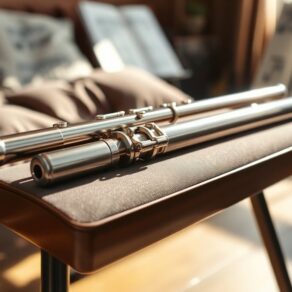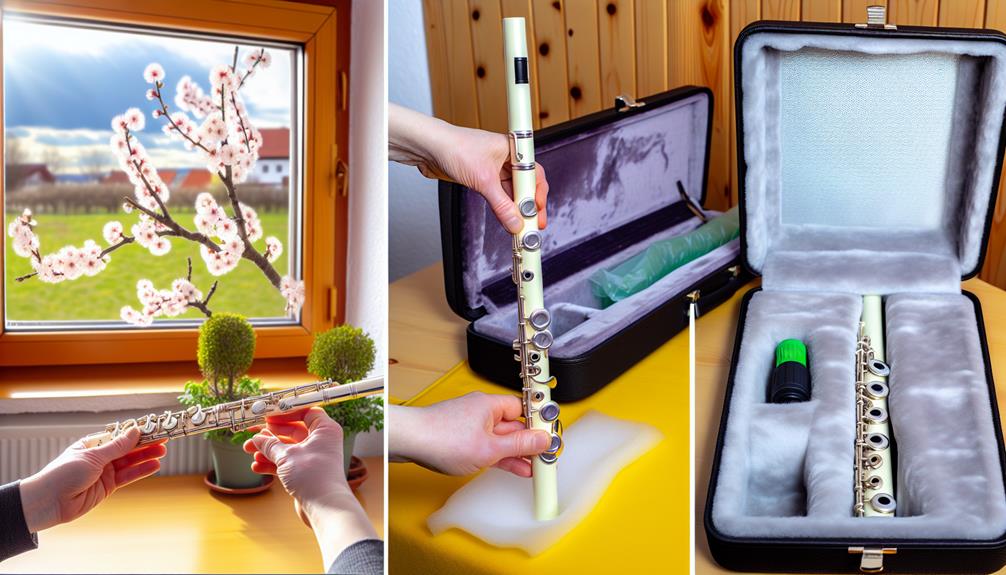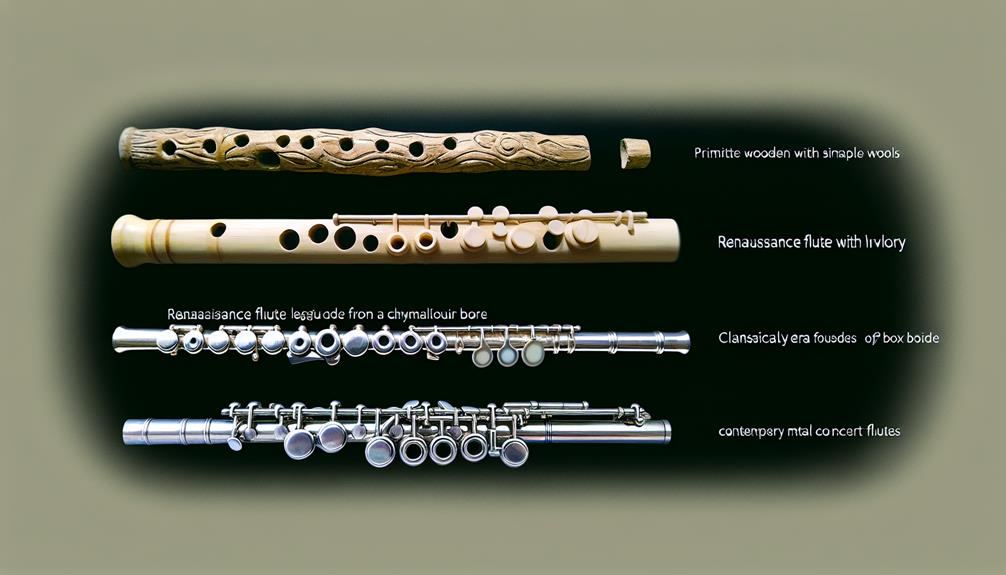Navigating the intricacies of flute playing demands precision and attention to detail. From hand positioning to breath support, there are common pitfalls that can impede a musician's progress. By addressing these missteps head-on, players can elevate their performance to new heights. Let's explore how mastering these fundamental aspects can transform not only the sound produced but also the overall musical experience.
Key Takeaways
- Ensure proper wrist alignment and fingerings for clear tones and accuracy.
- Form precise embouchure with steady airflow and firm aperture for consistent tone quality.
- Maintain correct posture with straight back and engaged core muscles for optimal airflow.
- Focus on proper breathing techniques, diaphragmatic control, and sustained notes for breath support.
- Vary vibrato speeds, listen for tone changes, and control vibrato for balanced musical expression.
Incorrect Hand Position
When playing the flute, ensuring correct hand position is crucial to producing clear and resonant tones with ease and precision. Proper wrist alignment plays a significant role in achieving this. The wrists should be kept straight and level with the forearm, allowing for fluid movement and control over the flute. Incorrect wrist alignment can lead to tension in the hands and arms, affecting the player's ability to navigate the flute comfortably.
Moreover, using the correct fingerings is essential for playing the flute accurately. Each finger must be placed on the appropriate key to produce the intended note. Practicing proper fingerings helps develop muscle memory, enabling smooth transitions between notes and passages. Incorrect finger placements can result in missed notes, squeaks, or a lack of clarity in the sound produced.
To ensure correct hand position while playing the flute, beginners should focus on maintaining a relaxed posture, with shoulders down and elbows slightly raised. The flute should be held parallel to the ground, allowing for a straight air stream into the instrument. Regularly checking and adjusting hand position during practice sessions can help in developing muscle memory and promoting proper technique.
Improper Embouchure Technique
Developing a precise and effective embouchure technique is fundamental for flute players aiming to produce a consistent and controlled tone quality. Improper embouchure, characterized by incorrect lip placement, can significantly hinder a flutist's ability to produce clear and resonant tones. Proper lip placement involves forming a small, firm aperture by rolling the lower lip slightly inwards and resting it against the lower teeth, while the upper lip rests lightly on the upper part of the flute's embouchure hole. Failure to maintain this position can lead to airy or muffled sounds due to air leaks or obstructions.
Furthermore, inadequate air support resulting from improper embouchure technique can also impact tone production. Flutists must learn to engage their diaphragm muscles to provide a steady and controlled stream of air through the flute. Without sufficient air support, notes may sound weak, uneven, or lack projection. To correct this, players should focus on developing a strong core and practicing breathing exercises to enhance their air capacity and control.
Lack of Proper Posture
Maintaining correct posture is essential for flute players as it directly impacts their ability to produce a consistent and resonant tone quality. Proper seating and body alignment play a crucial role in achieving optimal flute playing posture. Here are some key points to consider:
- Proper Seating:
- Sit on the edge of a chair with your feet flat on the ground.
- Ensure your back is straight, and your shoulders are relaxed.
- Avoid slouching or leaning too far back, as this can restrict airflow and affect tone production.
In addition to proper seating, incorporating breathing exercises into your practice routine can help improve posture and enhance your overall flute playing experience. By focusing on deep breathing techniques, flute players can develop better breath control, leading to more sustained notes and improved tone quality. Engaging in exercises that strengthen the core muscles can also support better posture while playing the flute.
Inadequate Breath Support
Insufficient breath support is a common challenge faced by flute players that can significantly impact their tone quality and overall performance. Proper breathing techniques are essential for flute players to produce a rich and resonant sound. When flute players do not have adequate breath support, their tone may sound weak, airy, or inconsistent. To address this issue, flute players should focus on developing their diaphragmatic breathing, which involves using the diaphragm to control the flow of air when playing the flute.
One way to improve breath support is by practicing long phrases with sustained notes. This exercise helps flute players build stamina and control over their airflow. Start by taking a deep breath and then exhaling slowly and steadily while playing a long note. Focus on maintaining a steady stream of air throughout the phrase without gasping for breath or letting the sound waver.
Additionally, pay attention to your posture when playing the flute. Proper alignment allows for better breath support and airflow. Sit or stand up straight, relax your shoulders, and keep your chest lifted to create more space for your lungs to expand. By incorporating proper breathing techniques and practicing long phrases, flute players can enhance their tone quality and overall performance.
Overuse of Vibrato
Excessive vibrato can detract from the purity and clarity of a flute player's tone, hindering the overall musical expression and interpretation. While vibrato is a beautiful expressive tool when used appropriately, overuse can mask the natural timbre of the flute and detract from the intended musical message. To avoid this common mistake, flute players should focus on vibrato control and tone quality.
Here are some practical tips to help maintain a balanced approach to vibrato:
- Experiment with Different Vibrato Speeds: By varying the speed of your vibrato, you can achieve different expressive effects. Experiment with slow, moderate, and fast vibrato to find the right balance for each musical passage.
- Listen Closely to Tone Changes: Pay attention to how vibrato affects your tone quality. Be mindful of any shifts in sound color or pitch instability that may arise from excessive vibrato usage.
- Practice Without Vibrato: To develop greater control, practice playing certain passages without vibrato. This exercise can help you focus on producing a pure and clear tone, enhancing your overall musical expression.
Neglecting Regular Maintenance
An essential aspect of preserving the optimal performance and longevity of a flute is consistent attention to its upkeep and maintenance. Neglecting regular maintenance can lead to a variety of issues such as sticky keys, leaks, poor tone quality, and even structural damage. To ensure your flute remains in top condition, it is crucial to follow proper instrument care practices and seek repair services when needed.
| Instrument Care | Repair Services |
|---|---|
| – Clean your flute after each use with a soft cloth to remove moisture and debris. | – Regularly schedule professional maintenance checks to detect and address any potential issues. |
| – Store your flute in a protective case when not in use to prevent dust buildup and accidental damage. | – Address any minor repairs promptly to prevent them from escalating into more significant problems. |
| – Avoid exposing your flute to extreme temperatures or humidity levels that can warp its components. | – Consult with a qualified repair technician for any adjustments needed to improve playability and sound quality. |
| – Have your flute serviced annually to maintain its mechanisms, pads, and overall condition. | – Invest in quality repair services to prolong the lifespan of your instrument and ensure optimal performance. |
Frequently Asked Questions
How Can I Prevent My Flute From Getting Clogged With Moisture During Playing?
To prevent your flute from getting clogged with moisture during playing, implementing proper moisture management techniques is crucial.
Some effective tips include taking breaks to allow the flute to dry out, using a cleaning rod with a cloth to remove excess moisture, and storing the flute in a dry and ventilated case when not in use.
These practices will help maintain the integrity and functionality of your flute over time.
Is It Okay to Use a Mirror to Check My Hand Position While Playing the Flute?
Utilizing a mirror to monitor hand positioning while playing the flute can be a beneficial practice. It aids in ensuring proper posture and accurate finger placement, crucial elements for producing clear and melodious notes.
Observing oneself in a mirror allows for real-time adjustments, fostering muscle memory and enhancing overall performance. However, it is advisable to strike a balance, as excessive reliance on a mirror may divert attention from musical expression and connection with the instrument.
Can Wearing Glasses Affect My Embouchure Technique While Playing the Flute?
When considering the impact of wearing glasses on flute playing, it's essential to address potential challenges such as eye strain and lens fogging.
Glasses may inadvertently affect embouchure technique by causing discomfort or obstructing proper alignment. To mitigate these issues, ensuring the glasses fit securely and comfortably is crucial.
Additionally, periodic breaks to prevent eye strain and employing anti-fog solutions for lenses can help maintain optimal playing conditions and technique.
Should I Practice Breathing Exercises Away From My Flute to Improve Breath Support?
Engaging in breathing exercises away from the flute can significantly enhance breath support. Practicing specific techniques to improve posture and breath control can benefit flute players by increasing lung capacity and promoting relaxation.
How Often Should I Replace the Pads on My Flute to Maintain Its Quality Sound?
Regular inspection and maintenance of flute pads are crucial for preserving the instrument's quality tone. The frequency of pad replacement depends on several factors such as the material of the pad, usage intensity, and environmental conditions.
Typically, professional flutists recommend replacing pads every 3-5 years to ensure optimal performance and prevent tone deterioration. Monitoring pad condition and seeking guidance from a qualified technician can help maintain the longevity of your flute's sound quality.
Conclusion
In conclusion, avoiding common flute playing mistakes is essential for improving technique and overall performance.
Are you ready to take your flute playing to the next level by ensuring correct hand position, embouchure technique, posture, breath support, and vibrato usage?
By addressing these key areas and consistently practicing with attention to detail, you can enhance your musical expression and clarity of tone.
Stay mindful of these mistakes and strive for excellence in your flute playing journey.






